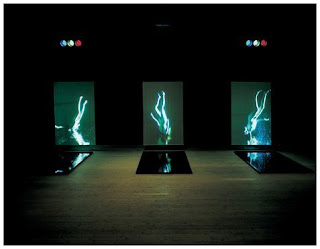Bill Viola emerged in the 70s at the birth of video art and is one of the major figures in an art whose expression depends on sound and image technology in New Media. He produces thought provoking and moving works that are about spirituality and other fundamental human experiences such as birth, death, love, and the aspects of consciousness.
From 1974-1976, Viola worked as technical director at Art/Tapes/22, a pioneering video studio in Florence, Italy where he encountered the work of Nam June Paik, Bruce Nauman, and Vito Acconci who were some of the pioneers of video art. He has collaborated with others including his wife Kira Perov.
Viola has drawn meaning and inspiration from an interest in Zen Buddhism, Christian mysticism, and Islamic Sufism. The subject matter and manner of western medieval and renaissance devotional art have also informed his aesthetic.
An ongoing theme that Viola explores is dualism, the idea that understanding comes from not only knowing the subject, but its opposite as well. His work deals with life and death, light and dark, as well as chaos and order. His stronger works combine a wonderful conceptual idea with a powerful visual experience. There is a painterly quality to his images, as he uses ultra-slow motion video allowing the viewer to fall into the image and connect with the deeper meanings contained in the work.
Viola started producing works in 1972, but the first video that I was exposed to was Chott el-Djerid (A Portrait in Light and Heat) which was made in 1979. It was recorded in the dry salt lake in the Tunisian Sahara Desert, where mirages are most likely to form in the midday sun. The intense desert heat bends and distorts the light rays to an extent that you see what is not really there. The images form a shimmering dance, as trees and sand dunes float off the ground and figures and shapes ripple and vibrate. These images are set against bleak winter landscape shots from North America. The climatic opposites induce a similar aura of uncertainty, disorientation, and unfamiliarity. These images cause us to reevaluate our perceptions of reality. The images are hallucinations of the landscape and the video creates the feeling of being in someone else's dream.
Over the decades Viola has made around 90-100 works and here are a few of my favorites.
Nantes Triptych (1992)
In the center a man floats under water fully clothed in a black pool. He is flanked on the left by an image of a woman giving birth, and on the right by an image of an old woman near death. Together they form a triptych based on the traditional altarpiece form. The two side panels are documents of actual events. The image in the middle depicts the human figure suspended between life and death.
Stations (1994)
Stations is an installation of five channels of video projection and sound focusing on the image of the human figure submerged under water. Five cloth screens are suspended from the ceiling and underneath each lies slabs of granite that reflect the image. The figures are strongly lit to stand out against the dark backgrounds. The suspended bodies are upside down and seem to float in slow motion. The figures slowly drift out of frame, and then in darkness they plunge into the water in an explosion of light and turbulence. After a while it subsides and the cycle starts again. An initial experience of serenity is interrupted by a disturbing disorder that evokes a feeling of being between dream and death.
The Veiling (1995)
Images of a man and a woman moving through a series of nocturnal landscapes are projected into parallel layers of cloth. Their images are projected from two opposing video projectors and show them moving from dark areas of shadow into light. The light is diffuse and the figures dissipate in intensity and focus as they move through the scrims eventually intersecting on the central veil. The man and the woman never exist in the same video frame. Only the light from their projections coexist in the fabric of the hanging veils.
The Crossing (1996)
The violent annihilation of a human figure by opposing natural forces of fire and water is projected simultaneously on two back-to-back screens. A man approaches from a long distance in slow motion until he finally stops. On one screen flames at his feet and quickly spread to his entire body. On the other screen water pours down from above until the figure is totally lost in the falling water. In the end, the man is gone as the image is reduced on one side to a flickering flame and on the other to a few lingering drops of water. The two traditional elements of fire and water are not only depicted in their destructiveness, but also in their ability to purify and transform.
Since the turn of the century Viola has continued to produce many works and has also developed an experimental video game called The Night Journey at the USC Game Innovation Lab and presented to the public in 2010.
Here are some image from the later works. Videos can be found on YouTube.
Emergence (2002)
Passage Into Night (2005)
The Fall Into Paradise (2005)
Purification (2005)
Dissolution (2005)
An Ocean Without A Shore (2007)
Viola has a theory that there are three structures to describe patterns of data. The most common structure is called branching, where the viewer proceeds from top to bottom in time, where the structure is clear and provides the path for you. The second structure is the matrix structure that follows a non-linear progression through information where the viewer has control of the path they follow. The third structure is called schizo which is based on randomness and where everything is irrelevant and significant at the same time. The viewer becomes lost and can never find their way out.













No comments:
Post a Comment